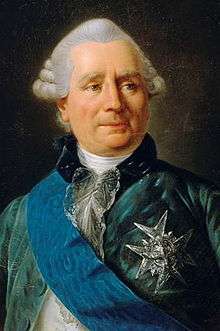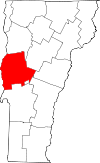Vergennes, Vermont
| Vergennes, Vermont | ||
|---|---|---|
| City | ||
|
Vergennes | ||
| ||
| Nickname(s): Little City on the Falls[1] | ||
 Vergennes, Vermont | ||
 Vergennes, Vermont Location in the United States | ||
| Coordinates: 44°9′56″N 73°15′8″W / 44.16556°N 73.25222°WCoordinates: 44°9′56″N 73°15′8″W / 44.16556°N 73.25222°W | ||
| Country | United States | |
| State | Vermont | |
| County | Addison | |
| Incorporated as a city | 1788 | |
| Government | ||
| • Mayor | William Benton | |
| Area | ||
| • Total | 2.5 sq mi (6.5 km2) | |
| • Land | 2.4 sq mi (6.2 km2) | |
| • Water | 0.1 sq mi (0.3 km2) | |
| Elevation | 194 ft (59 m) | |
| Population (2010) | ||
| • Total | 2,588 | |
| • Density | 1,141.1/sq mi (440.6/km2) | |
| Time zone | Eastern (EST) (UTC−5) | |
| • Summer (DST) | EDT (UTC−4) | |
| ZIP code | 05491 | |
| Area code | 802 Exchange: 877 | |
| FIPS code | 50-74650[2] | |
| GNIS feature ID | 1460018[3] | |
| Website | www.vergennes.org | |
Vergennes /vərˈdʒɛnz/ is a city located in the northwest quadrant of Addison County, Vermont. The municipality is bordered by the towns of Ferrisburgh, Panton and Waltham. As of the 2010 census the city population was 2,588. It is the smallest of Vermont's nine cities in terms of population, though the city of Winooski covers a smaller area. It was the first city chartered in the state of Vermont.[4]
History

Vergennes, first settled in 1766 by Donald MacIntosh, was established in 1788,[1] the only one of Vermont's cities not to have been first chartered as a Town or independent village. Instead, portions of the pre-existing Towns of New Haven, Panton and Ferrisburg, where they intersected at the Otter Creek Falls, were split off to form Vergennes.[1] It is the smallest city (by population) in Vermont.
The city is named for Frenchman Charles Gravier, Comte de Vergennes, who greatly aided the rebel colonial effort in the American Revolutionary War.[5] His hatred of the British and his desire for revenge after the French defeat in the French and Indian War (the North American front of the Seven Years' War won by the British), led him to support the American rebel colonists by arranging to send them arms and troops to the revolutionary cause. He worked with Beaumarchais to secretly procure arms and volunteers and get them to the Americans. As directed by Louis XVI, Gravier established a dummy company through which the Americans received nearly 80% of their military supplies from France. At the close of the war, Gravier negotiated the 1783 Treaty of Paris, which formally established peace between the United States and Britain.
Here, Thomas Macdonough built and armed the fleet that would defeat the British on Lake Champlain during the War of 1812. The Monkton Iron Company (which was at the time the largest iron works in the nation) manufactured the fittings for Macdonough's fleet, as well as most of the cannon shot used by the United States Army in the north. The ore used was mined in nearby Monkton.
Organizers settled on a city form of municipal government in the ambition to develop the area as an industrial center. The Otter Creek Falls provided power for mills and factories, and the close access to the Lake Champlain waterway was ideal for transportation both north and south. Industry boomed in the late nineteenth century; in particular, shipping connected to the Champlain Canal and wood-finishing related to lumber imported from Canada. As railways supplanted and bypassed the canal system, manufacturing declined in the city. A railroad spur from Ferrisburgh to the base of the falls proved a failure, as the grades were too steep for practical operations.
Commercial decline continued in the twentieth century, narrowing down to a few surviving companies. In the early years of the 21st century, a group of civic boosters and merchants improved the downtown area along Main Street and reconnected the city to its waterways. The resultant 'boutique Vergennes', catering to tourists and transients, is hampered by centralization of land ownership and escalation of commercial rents.
Geography
According to the United States Census Bureau, the city has a total area of 2.5 square miles (6.5 km2), of which 2.4 square miles (6.2 km2) is land and 0.1 square mile (0.3 km2) (4.00%) is water.
The city's borders form a rectangle, nearly a square. Otter Creek flows north through the town. In the middle of town is a 37-foot waterfall, with a large basin which occasionally floods.
Demographics

| Historical population | |||
|---|---|---|---|
| Census | Pop. | %± | |
| 1790 | 201 | — | |
| 1800 | 516 | 156.7% | |
| 1810 | 835 | 61.8% | |
| 1820 | 817 | −2.2% | |
| 1830 | 999 | 22.3% | |
| 1840 | 1,017 | 1.8% | |
| 1850 | 1,378 | 35.5% | |
| 1860 | 1,286 | −6.7% | |
| 1870 | 1,570 | 22.1% | |
| 1880 | 1,782 | 13.5% | |
| 1890 | 1,773 | −0.5% | |
| 1900 | 1,753 | −1.1% | |
| 1910 | 1,483 | −15.4% | |
| 1920 | 1,609 | 8.5% | |
| 1930 | 1,705 | 6.0% | |
| 1940 | 1,662 | −2.5% | |
| 1950 | 1,736 | 4.5% | |
| 1960 | 1,921 | 10.7% | |
| 1970 | 2,242 | 16.7% | |
| 1980 | 2,273 | 1.4% | |
| 1990 | 2,578 | 13.4% | |
| 2000 | 2,741 | 6.3% | |
| 2010 | 2,588 | −5.6% | |
| Est. 2015 | 2,631 | [6] | 1.7% |
| U.S. Decennial Census[7] | |||
As of the census[2] of 2010, there were 2,588 people, 979 households, and 632 families residing in the city. The population density was 1,141.1 people per square mile (441.0/km2). There were 1,032 housing units at an average density of 429.6 per square mile (166.0/km2). The racial makeup of the city was 92.8% White, 3.0% African American, 0.3% Native American, 0.9% Asian, 0.04% Pacific Islander, 0.7% from other races, and 2.3% from two or more races. Hispanic or Latino of any race were 2.6% of the population.
There were 979 households out of which 34.3% had children under the age of 18 living with them, 48.8% were married couples living together, 11.6% had a female householder with no husband present, and 35.4% were non-families. 28.2% of all households were made up of individuals and 12.5% had someone living alone who was 65 years of age or older. The average household size was 2.47 and the average family size was 3.02.
In the city the age distribution of the population shows 28.4% under the age of 18, 13.1% from 18 to 24, 27.8% from 25 to 44, 19.3% from 45 to 64, and 11.3% who were 65 years of age or older. The median age was 33 years. For every 100 females there were 100.4 males. For every 100 females age 18 and over, there were 93.8 males.
Economy
Personal income
The median income for a household in the city was $37,763, and the median income for a family was $48,155. Males had a median income of $33,669 versus $20,527 for females. The per capita income for the city was $15,465. About 8.1% of families and 17.0% of the population were below the poverty line, including 8.5% of those under age 18 and 16.0% of those age 65 or over.
Manufacturing
The Goodrich Corporation employs approximately 800 people although Goodrich has been since bought out by UTC Aerospace.
Schools
Vergennes has four schools: Vergennes Union Elementary School, Vergennes Union High School, Champlain Valley Christian School, and Northlands Job Corps Center, the former Weeks School, which served as an orphanage and juvenile delinquent home until the late 1970s, in the same facility.
Vergennes Union High School also offers an alternative public program, the Walden Project, available to area students.
Culture

The city features the Vergennes Opera House, which has weekly events involving the community and special guests, bands, singers, politicians and theater groups. The city has a library, the Bixby Memorial Free Library.[8]
Notable people
- Joseph K. Edgerton, US congressman from Indiana
- Margaret Foley, sculptor
- Ethan A. Hitchcock, US army officer and author
- Charles B. Lawrence, Chief Justice of the Illinois Supreme Court
- Henry Porter, pitcher with the Milwaukee Brewers, Brooklyn Grays, and Kansas City Cowboys
- Daniel H. Pulcifer, Wisconsin State Assemblyman and mayor of Shawano, Wisconsin
- Frederick E. Woodbridge, US congressman and mayor of Vergennes
References
- 1 2 3 Vergennes.org
- 1 2 "American FactFinder". United States Census Bureau. Archived from the original on September 11, 2013. Retrieved 2008-01-31.
- ↑ "US Board on Geographic Names". United States Geological Survey. 2007-10-25. Retrieved 2008-01-31.
- ↑ "Archived copy". Archived from the original on June 9, 2007. Retrieved December 17, 2011.
- ↑ City of Vergennes. (n.d.). City of Vergennes. Retrieved January 2, 2010.
- ↑ "Annual Estimates of the Resident Population for Incorporated Places: April 1, 2010 to July 1, 2015". Retrieved July 2, 2016.
- ↑ "American Factfinder". United States Census Bureau. Retrieved May 16, 2015.
- ↑ Bixby Memorial Free Library


